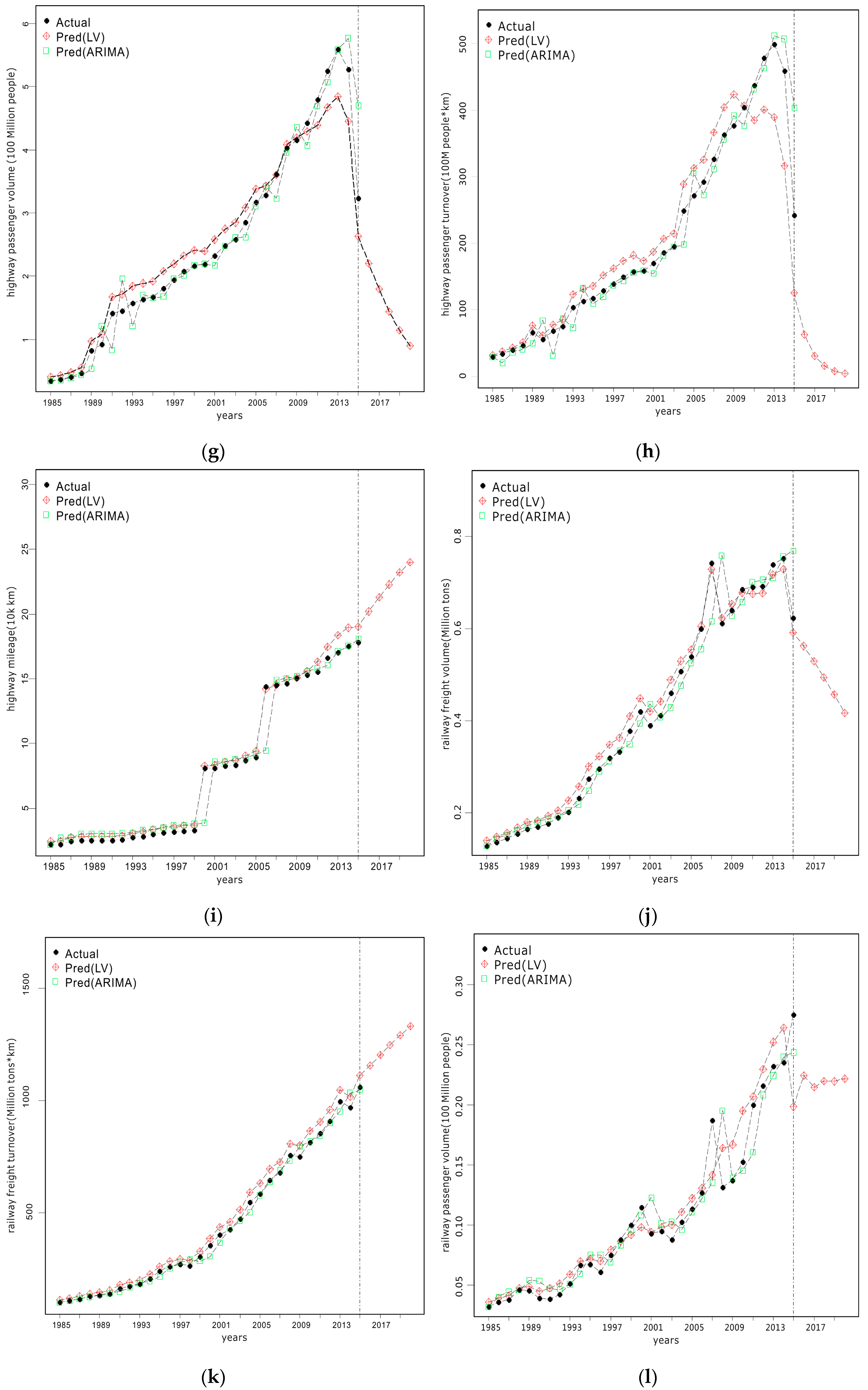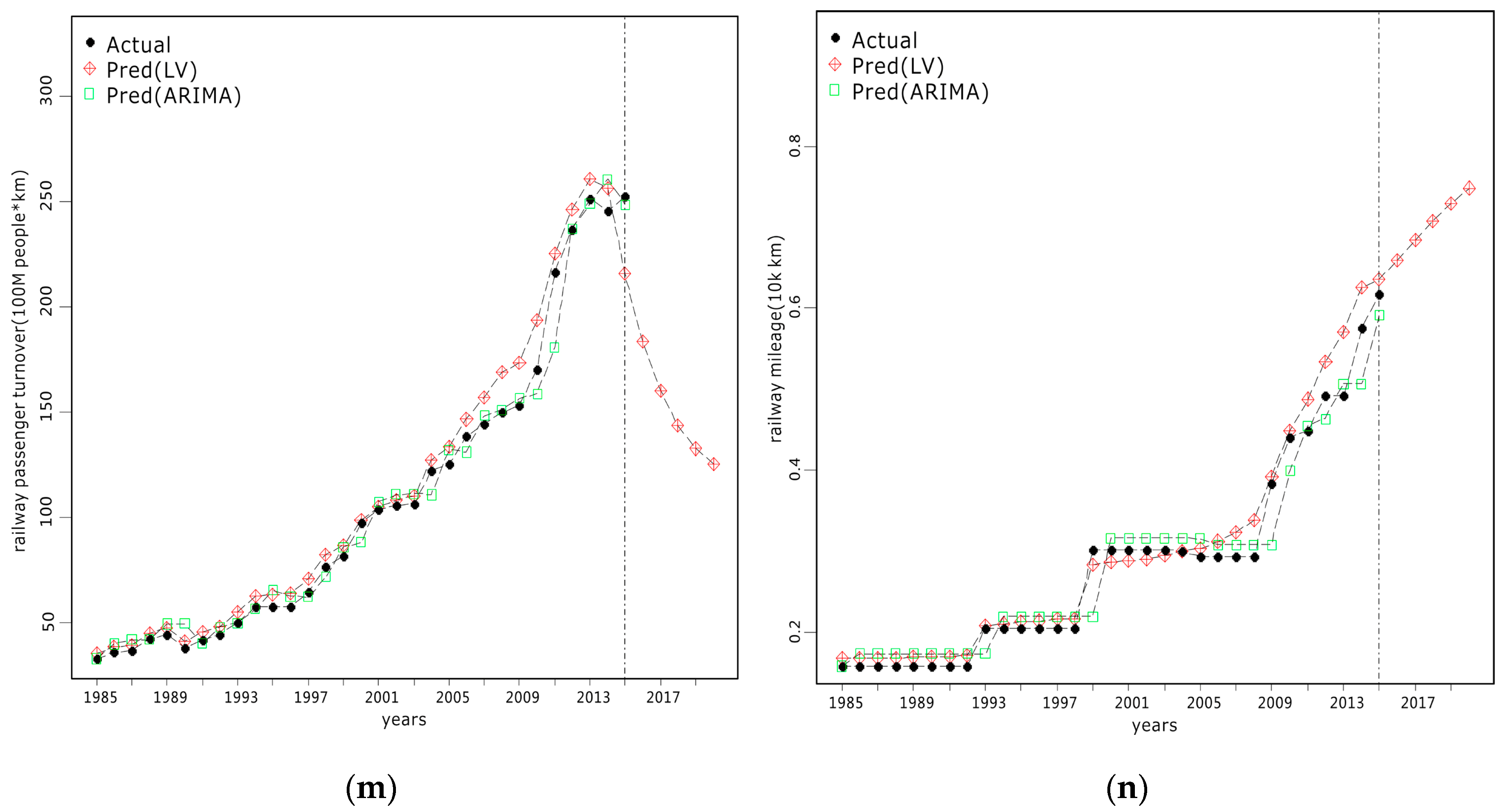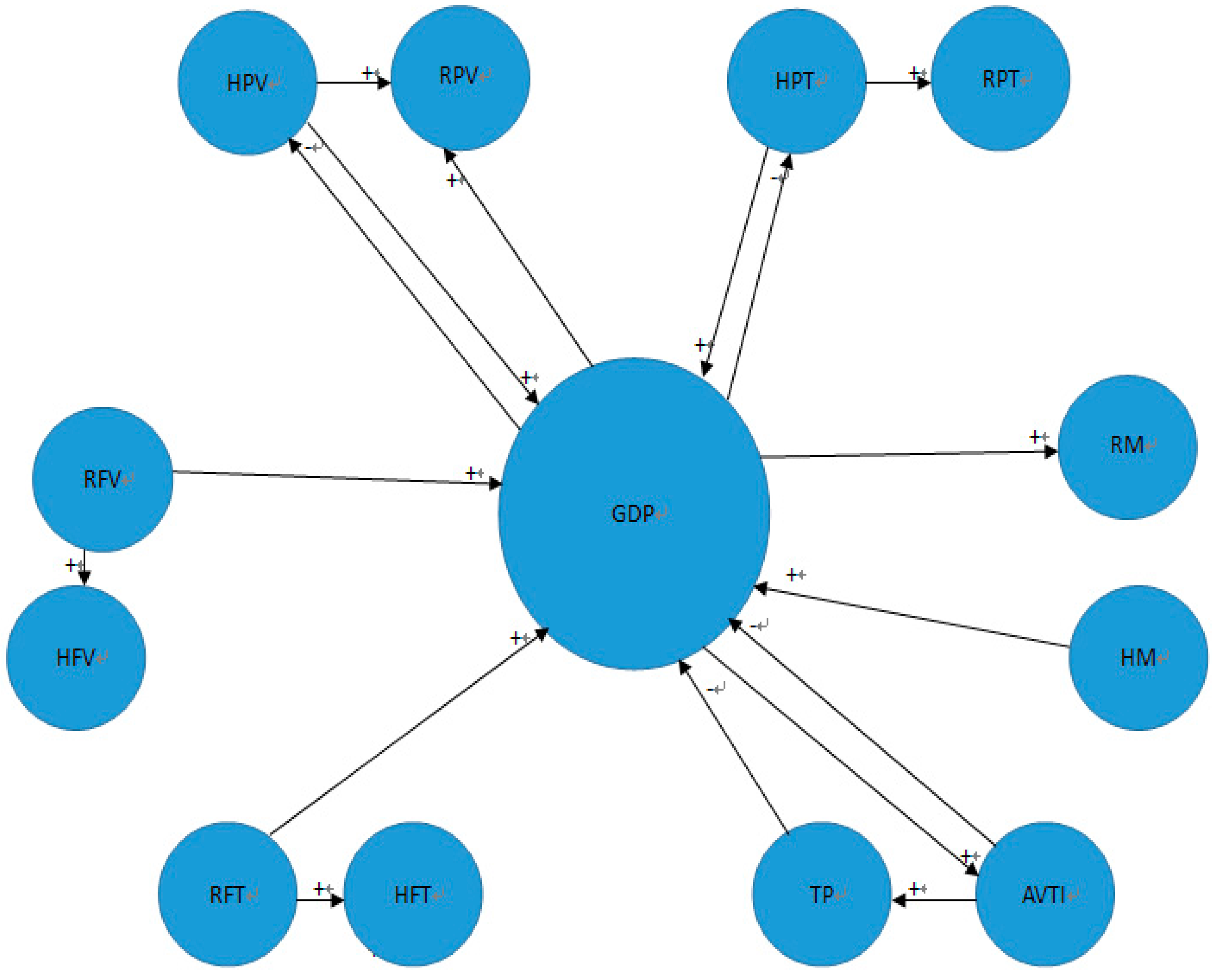Study on the Relationship between Land Transport and Economic Growth in Xinjiang
Abstract
:1. Introduction
2. Study Area
3. Materials and Methods
3.1. Competitive Model
- (1)
- Pure competition, when bij > 0 and bji > 0 and both factors inhibit the other’s growth;
- (2)
- Mutualism, when bij < 0 and bji < 0 and both factors enhance the other’s growth;
- (3)
- Neutralism, when bij = 0 and bji = 0 and the two factors have no interaction;
- (4)
- Predator-prey, when bij > 0 and bji < 0 and factor i enhances factor j’s growth, but factor j inhibits the growth of factor i;
- (5)
- Amensalism, when bij > 0 and bji = 0 and factor i suffers from the existence of the factor j, but factor j is unaffected by factor i; and
- (6)
- Commensalism, when bij < 0 and bji = 0 and factor i obtains benefits from factor j without either harming or benefiting factor j.
3.2. ARIMA Models
4. Results
4.1. Descriptive Statistics
4.2. Analysis of the Competitive Relationships
4.2.1. The Relationship between GDP and Land Transportation
4.2.2. The Competitive Relationship among the Economic Indicators of Transportation and Their Relationship with GDP
4.3. Forecasting Land Transportation, the Economic Indicators of Transportation and GDP
5. Conclusions and Discussion
Acknowledgments
Author Contributions
Conflicts of Interest
References
- Yang, Z.S.; Fan, J.M. Transportation and Economic Development. Econ. Issues 1995, 8, 42–43. [Google Scholar]
- Lu, D.D. The Theory and Practice of China’s Regional Development, 1st ed.; Science Press: Beijing, China, 2003; pp. 221–222. ISBN 9787030112040. [Google Scholar]
- Edward, J.T.; Howard, L.G. Geography of Transportation, 2nd ed.; Prentice Hall: Upper Saddle River, NJ, USA, 1996; pp. 38–43. ISBN 0133685721. [Google Scholar]
- Liu, J.Q.; He, J.H. An Empirical Study on the Development of Transportation Industry and National Economy. J. Transp. Syst. Eng. 2002, 2, 82–86. [Google Scholar]
- Garcia, M.T.; McGuire, T.J.; Porter, R.H. The effect of public capital in state level production functions reconsidered. Rev. Econ. Stat. 1996, 78, 177–180. [Google Scholar] [CrossRef]
- Holtz, E.D.; Schwarz, A.E. Spatial productivity spillovers from public infrastructure: Evidence from state highways. Int. Tax Public Financ. 1995, 2, 459–468. [Google Scholar] [CrossRef]
- Mehmet, A.B.; Müge, K.; Hakan, Y. Granger-causality between transportation and GDP: A panel data approach. Transp. Res. Part A 2014, 63, 43–55. [Google Scholar]
- Michael, I.; David, L. Mutual causality in road network growth and economic development. Transp. Policy 2016, 45, 209–217. [Google Scholar]
- Kveiborg, O.; Fosgerau, M. Decomposing the decoupling of Danish road freight traffic growth and economic growth. Transp. Policy 2007, 14, 39–48. [Google Scholar] [CrossRef]
- Li, Y.C.; Zhao, L.; Suo, J.J. Comprehensive Assessment on Sustainable Development of Highway Transportation Capacity Based on Entropy Weight and TOPSIS. Sustainability 2014, 6, 4685–4693. [Google Scholar] [CrossRef]
- Feng, H. An Analysis of the Contribution of Highway Traffic to Xinjiang’s National Economic Growth. Master’s Thesis, Shanghai Maritime University, Shanghai, China, 2005. [Google Scholar]
- Xu, C.F. Research of the Relationship between Highway Traffic and the Development of Economy and Society in Xinjiang Production and Construction Corps. Ph.D. Thesis, Wuhan University of Technology, Wuhan, China, 2011. [Google Scholar]
- Zhu, Y.N. Research on the relationship between regional transport and regional economic in southern Xinjiang. Master’s Thesis, Beijing Jiaotong University, Beijing, China, 2011. [Google Scholar]
- Zhang, L.; Zhang, X.L.; Du, H.R.; Ni, T.Q. The Different Impact of Passenger Traffic Way son the Different Economic Growth in Xinjiang Region. J. Chongqing Norm. Univ. (Nat. Sci.) 2016, 33, 211–216. [Google Scholar]
- Lotka, A.J. Elements of Physical Biology, 1st ed.; Williams & Wilkins Co.: Baltimore, MA, USA, 1925. [Google Scholar]
- Volterra, V. Leconssur la Theoriemathematique de la Lutte Pour la vie; Gauthier-Villars: Paris, France, 1931. [Google Scholar]
- Wang, X.W. Analysis on application effect of Xinjiang Highway Transportation 11th Five-year Plan. Master’s Thesis, Changan University, Xi’an, China, 2010. [Google Scholar]
- Development Plan of “13th Five—Year Plan” of Transportation in Xinjiang Uygur Autonomous Region. Available online: http://www.xjjt.gov.cn/article/2015-11-23/art84330.html (accessed on 3 July 2015).
- Box, G.E.P.; Jenkins, G.M. Time Series Analysis: Forecasting and Control; Holden-Day: San Francisco, CA, USA, 1976. [Google Scholar]
- Lewis, C.D. Industrial and Business Forecasting Methods: A Practical Guide to Exponential Smoothing and Curve Fitting; Butter-Worth-Heinemann: London, UK, 1982. [Google Scholar]
- Girifalco, L.A. Dynamics of Technological Change, 1st ed.; Van Nostrand Reinhold: New York, NY, USA, 1991; ISBN 978-1-4684-6511-2. [Google Scholar]
- Liu, P.Z.; Gopalsamy, K. On a model of competition in periodic environments. Appl. Math. Comput. 1997, 82, 207–238. [Google Scholar] [CrossRef]
- Pistorius, C.W.I.; Utterback, J.M. A Lotka-Volterra Model for Multi-Mode Technological Interaction: Modelling Competition, Symbiosis and Predator Prey Modes; Working Papers; Massachusetts Institute of Technology (MIT), Sloan School of Management: Cambridge, MA, USA, 1996; pp. 3929–3996. [Google Scholar]
- Hart, T. Transport Investment and Disadvantage Regions: UK and European policies since the 1950s. Urban Stud. 1993, 30, 417–435. [Google Scholar] [CrossRef]
- Banister, D. Transport Planning in the UK, USA and Europe, 1st ed.; E & FN Spon: London, UK, 1994; ISBN 0-419-18930-0. [Google Scholar]
- Aschauer, A.D. Is Public Expenditure Productive? J. Monetary Econ. 1988, 23, 177–200. [Google Scholar] [CrossRef]
- Munnell, A.H. Why Has Productivity Growth Declined? Productivity and Public Investment. N. Engl. Econ. J. Rev. 1990, 30, 3–22. [Google Scholar]
- Durkin, J.T., Jr.; Wassmer, R.W. Public Infrastructure Spending and Private Generation in Large US Cities; Working Paper; Lincoln Institute of Land Policy: Cambridge, MA, USA, 1994. [Google Scholar]
- Holtz-Eakin, D.; Schwartz, A.E. Infrastructure in a Structural Model of Economic Growth. Reg. Sci. Urban Econ. 1994, 25, 131–151. [Google Scholar] [CrossRef]
- Botham, R. Regional Development Effects of Road Investment. Transp. Plan. Technol. 1980, 6, 97–108. [Google Scholar] [CrossRef]
- Liu, X.T.; Chen, W.J. Dynamics of spatial pattern of county's economics during 2004–2013 in Xinjiang, China. J. Desert Res. 2015, 35, 1089–1095. [Google Scholar]




| Variables | Description | Variables | Description |
|---|---|---|---|
| X1 | Gross Domestic Product (GDP) | X8 | Highway freight turnover (HFT) |
| X2 | Highway passenger volume (HPV) | X9 | Railway freight turnover (RFT) |
| X3 | Railway passenger volume (RPV) | X10 | Highway mileage (HM) |
| X4 | Highway passenger turnover (HPT) | X11 | Railway mileage (RM) |
| X5 | Railway passenger turnover (RPT) | X12 | Added value of transportation industry (AVTI) |
| X6 | Highway freight volume (HFV) | X13 | Total population (TP) |
| X7 | Railway freight volume (RFV) | X14 | Transportation investment (TI) |
| GDP | HPV | RPV | HPT | RPT | HFV | RFV | HFT | RFT | HM | RM | AVTI | TI | TP | |
|---|---|---|---|---|---|---|---|---|---|---|---|---|---|---|
| 5-year | 11.4 | −6.1 | 12.6 | −9.8 | 8.2 | 5.0 | −1.9 | 6.7 | 5.4 | 3.1 | 7.0 | 19.2 | 19.6 | 1.6 |
| 10-year | 13.6 | 0.2 | 9.3 | −1.2 | 7.3 | 6.9 | 1.5 | 10.1 | 6.1 | 7.1 | 7.7 | 13.6 | 17.0 | 1.6 |
| 15-year | 13.7 | 2.6 | 6.0 | 2.9 | 6.6 | 6.0 | 2.7 | 9.5 | 7.6 | 5.4 | 4.9 | 8.9 | 19.2 | 1.6 |
| Panel A: GDP-HPV-RPV | ||||||||
| GDP | HPV | RPV | ||||||
| Parameter | Estimates | t-Stat | Parameter | Estimates | t-Stat | Parameter | Estimates | t-Stat |
| α1 | 1.23 *** | 11.88 | α2 | 1.21 ** | 2.59 | α3 | 1.41 ** | 2.62 |
| β11 | −3.48 × 10−6 *** | 14.82 | β21 | 3.61 × 10−5 *** | −3.08 | β31 | −1.50 × 10−4 *** | 2.89 |
| β12 | −0.02 ** | 2.54 | β22 | −0.01 *** | 8.37 | β32 | −0.15 * | 1.88 |
| β13 | 1.15 | −0.40 | β23 | 0.66 | 0.20 | β33 | 10.28 | 1.11 |
| R2 | 0.98 | 0.96 | 0.92 | |||||
| MAPE | 0.16 | 0.12 | 0.11 | |||||
| Panel B: GDP-HPT-RPT | ||||||||
| GDP | HPT | RPT | ||||||
| Parameter | Estimates | t-Stat | Parameter | Estimates | t-Stat | Parameter | Estimates | t-Stat |
| α1 | 1.26 *** | 11.88 | α2 | 1.09 ** | 2.29 | α3 | 1.16 ** | 4.90 |
| β11 | −1.13 × 10−5 *** | 12.35 | β21 | 1.25 × 10−4 *** | −4.55 | β31 | −3.23 × 10−5 | 0.38 |
| β12 | −7.19 × 10−4 *** | 3.57 | β22 | −2.28 × 10−3 *** | 8.41 | β32 | −1.02 × 10−3 ** | 2.61 |
| β13 | 2.49 × 10−3 | −0.99 | β23 | 1.91 × 10−3 | 0.34 | β33 | 3.60 × 10−3 *** | 3.79 |
| R2 | 0.98 | 0.91 | 0.98 | |||||
| MAPE | 0.16 | 0.14 | 0.07 | |||||
| Panel C: GDP-HFV-RFV | ||||||||
| GDP | HFV | RFV | ||||||
| Parameter | Estimates | t-Stat | Parameter | Estimates | t-Stat | Parameter | Estimates | t-Stat |
| α1 | 1.29 *** | 11.88 | α2 | 1.28 *** | 3.45 | α3 | 1.07 *** | 3.43 |
| β11 | −3.31 × 10−5 *** | 12.26 | β21 | −9.76 × 10−5 | 1.25 | β31 | 3.48 × 10−5 | −1.44 |
| β12 | 0.08 | −1.17 | β22 | 0.22 *** | 2.89 | β32 | −0.05 | 0.99 |
| β13 | −0.16 ** | 2.76 | β23 | −0.58 ** | 2.71 | β33 | 0.23 *** | 7.94 |
| R2 | 0.98 | 0.98 | 0.99 | |||||
| MAPE | 0.16 | 0.07 | 0.06 | |||||
| Panel D: GDP-HFT-RFT | ||||||||
| GDP | HFT | RFT | ||||||
| Parameter | Estimates | t-Stat | Parameter | Estimates | t-Stat | Parameter | Estimates | t-Stat |
| α1 | 1.21 *** | 11.88 | α2 | 1.23 *** | 4.42 | α3 | 1.10 *** | 8.87 |
| β11 | −1.16 × 10−5 *** | 6.64 | β21 | −1.58 × 10−4 | 1.08 | β31 | 6.05e−07 | 0.04 |
| β12 | 2.43 × 10−4 | 0.13 | β22 | 1.82 × 10−3 ** | 2.22 | β32 | 1.96 × 10−5 | −0.33 |
| β13 | −5.17 × 10−5 ** | 2.66 | β23 | −4.39 × 10−4 *** | 3.35 | β33 | 2.32 × 10−5 *** | 17.00 |
| R2 | 0.98 | 0.98 | 0.99 | |||||
| MAPE | 0.16 | 0.10 | 0.08 | |||||
| Panel E: GDP-HM-RM | ||||||||
| GDP | HM | RM | ||||||
| Parameter | Estimates | t-Stat | Parameter | Estimates | t-Stat | Parameter | Estimates | t-Stat |
| α1 | 1.23 *** | 11.88 | α2 | 1.19 ** | 2.16 | α3 | 1.35 ** | 2.50 |
| β11 | 7.66 × 10−6 *** | 14.93 | β21 | −3.44 × 10−5 | −0.91 | β31 | −8.38 × 10−5 ** | 2.63 |
| β12 | −3.35 × 10−3 ** | 2.49 | β22 | 1.66 × 10−2 *** | 8.67 | β32 | −1.98 × 10−5 | −0.03 |
| β13 | 0.25 | 0.71 | β23 | 0.22 | 1.68 | β33 | 1.77 *** | 4.92 |
| R2 | 0.98 | 0.99 | 0.95 | |||||
| MAPE | 0.16 | 0.07 | 0.06 | |||||
| Panel F: GDP-AVTI-TI | ||||||||
| GDP | AVTI | TI | ||||||
| Parameter | Estimates | t-Stat | Parameter | Estimates | t-Stat | Parameter | Estimates | t-Stat |
| α1 | 1.22 *** | 11.88 | α2 | 1.31 *** | 6.56 | α3 | 1.24 *** | 3.97 |
| β11 | −1.37 × 10−5 *** | 11.63 | β21 | −1.10 × 10−4 *** | 3.26 | β31 | −1.14 × 10−4 | 0.10 |
| β12 | 7.83 × 10−4 | −1.22 | β22 | 2.93 × 10−3 *** | 8.58 | β32 | 6.07 × 10−4 | 1.44 |
| β13 | −1.28 × 10−4 | −0.95 | β23 | −8.96 × 10−5 | −1.21 | β33 | 1.34 × 10−3 *** | 5.18 |
| R2 | 0.98 | 0.95 | 0.93 | |||||
| MAPE | 0.16 | 0.18 | (0.23) | |||||
| Panel G: GDP-AVTI-TP | ||||||||
| GDP | AVTI | TP | ||||||
| Parameter | Estimates | t-Stat | Parameter | Estimates | t-Stat | Parameter | Estimates | t-Stat |
| α1 | 1.38 *** | 11.88 | α2 | 28.70 *** | 6.56 | α3 | 1.05 *** | 12.21 |
| β11 | −2.58 × 10−5 *** | 22.84 | β21 | −2.65 × 10−3 *** | 3.78 | β31 | 2.12 × 10−6 | −1.43 |
| β12 | 6.86 × 10−4 *** | −3.63 | β22 | 3.47 × 10−2 *** | 7.37 | β32 | −8.92 × 10−5 ** | 2.08 |
| β13 | 0.87 *** | 4.16 | β23 | 138.57 | −0.49 | β33 | 0.23 *** | 45.08 |
| R2 | 0.98 | 0.94 | 0.99 | |||||
| MAPE | 0.16 | 0.18 | 0.02 | |||||
| Panel H: GDP-TI-TP | ||||||||
| GDP | TI | TP | ||||||
| Parameter | Estimates | t-Stat | Parameter | Estimates | t-Stat | Parameter | Estimates | t-Stat |
| α1 | 1.61 *** | 11.88 | α2 | 8.44 × 1035 *** | 3.97 | α3 | 1.04 *** | 12.21 |
| β11 | −1.40 × 10−5 *** | 10.53 | β21 | −1.61 × 1032 | 1.53 | β31 | 2.15 × 10−6 | −0.97 |
| β12 | 9.37 × 10−5 | −0.85 | β22 | 1.57 × 1033 *** | 5.17 | β32 | −3.66 × 10−5 | 1.16 |
| β13 | 2.25 * | 2.04 | β23 | 4.61 × 1036 | −1.65 | β33 | 0.10 *** | 50.68 |
| R2 | 0.98 | (0.80) | 0.99 | |||||
| MAPE | 0.16 | (0.24) | 0.02 | |||||
| GDP | HPV | RPV | HFV | RFV | HM | RM | AVTI | TI | TP | |
|---|---|---|---|---|---|---|---|---|---|---|
| 2016 | 10,336.9 | 2.21 | 0.22 | 7.59 | 0.56 | 20.18 | 0.66 | 562.97 | 949.1 | 0.25 |
| 2017 | 10,807.07 | 1.79 | 0.21 | 8.04 | 0.53 | 21.28 | 0.68 | 559.81 | 921.9 | 0.26 |
| 2018 | 11,240.44 | 1.44 | 0.22 | 8.52 | 0.49 | 22.28 | 0.71 | 553.25 | 1093.0 | 0.26 |
| 2019 | 11,634.49 | 1.14 | 0.22 | 9.04 | 0.46 | 23.19 | 0.73 | 547.84 | 1086.1 | 0.27 |
| 2020 | 11,988.91 | 0.90 | 0.22 | 9.59 | 0.42 | 24.00 | 0.75 | 546.63 | 1274.4 | 0.27 |
| CAGR-lv (%) | 5.15 | −19.40 | 2.24 | 5.97 | −6.75 | 4.76 | 3.33 | 0.39 | 4.61 | 2.81 |
| RE-LV (2016) | 0.07 | −0.24 | −0.3 | 0.17 | −0.19 | 0.11 | −0.07 | −0.01 | 0.14 | 0.04 |
| RE-LV(2020) | −0.08 | −0.9 | −0.62 | −0.24 | −0.76 | 0.26 | −0.25 | −0.15 | −0.03 | 0.03 |
© 2018 by the authors. Licensee MDPI, Basel, Switzerland. This article is an open access article distributed under the terms and conditions of the Creative Commons Attribution (CC BY) license (http://creativecommons.org/licenses/by/4.0/).
Share and Cite
Sun, J.; Li, Z.; Lei, J.; Teng, D.; Li, S. Study on the Relationship between Land Transport and Economic Growth in Xinjiang. Sustainability 2018, 10, 135. https://doi.org/10.3390/su10010135
Sun J, Li Z, Lei J, Teng D, Li S. Study on the Relationship between Land Transport and Economic Growth in Xinjiang. Sustainability. 2018; 10(1):135. https://doi.org/10.3390/su10010135
Chicago/Turabian StyleSun, Jingxin, Zhinong Li, Jiaqiang Lei, Dexiong Teng, and Shengyu Li. 2018. "Study on the Relationship between Land Transport and Economic Growth in Xinjiang" Sustainability 10, no. 1: 135. https://doi.org/10.3390/su10010135
APA StyleSun, J., Li, Z., Lei, J., Teng, D., & Li, S. (2018). Study on the Relationship between Land Transport and Economic Growth in Xinjiang. Sustainability, 10(1), 135. https://doi.org/10.3390/su10010135




